To organize heating in a private house, you can use systems that differ in the type of heat exchangers. The most popular are bimetal radiators, which combine the properties of several types. When choosing radiators, you need to study their technical characteristics in order to correctly calculate the power and number of sections necessary for heating the room.
Heat transfer and its use
When studying the characteristics of a radiator, it is important to pay attention to heat transfer. This concept includes the amount of heat that is released by the radiator over a certain period of time. The heat flux or power of a device is measured in watts. For bimetallic radiators, this figure is 200 watts.
In technical documentation, heat transfer is often indicated in calories in one hour, which using the formula can be converted to watts. 1 watt is equal to 859.8 calories per hour.
Three processes occur as a result of battery operation. Due to this, heat is released. Room heating is due to:
- heat transfer;
- convection;
- radiation.
For the operation of any model of heating appliances, the use of all processes is characteristic. The difference is only in the proportions.
Sizes and capacity of sections
The popularity of bimetallic radiators is due to their compactness. Thanks to the steel inserts, they look more accurate than cast iron. The smaller one section in size, the less heat will be needed for heating. Consequently, the use of this type of battery in terms of energy consumption will be more economical. But very narrow pipes have a minus. They quickly become clogged with debris that moves through heating networks. It is better to choose models of bimetallic radiators with thin walls, like water pipes.
The parameters of the battery capacity are affected by the distance between the axles. Heat transfer depends on the capacity of the radiator itself. For example, this parameter for a battery with a center distance of 20 cm is from 0.1 to 0.16 liters.
The main feature of bimetal radiators is a small amount of coolant. But at the same time, the heat flux will be enough to heat the premises as efficiently as possible. For example, a device of ten sections of 35 cm can heat a room of 14 square meters, but at the same time it contains only 1.6 liters.
Bimetallic batteries can be assembled independently in one section or you can purchase a ready-made radiator of the right size.
The number of sections of the bimetallic radiator
How many kilowatts in one section of an aluminum radiator or a bimetallic battery are indicated in the technical data sheet of the equipment. All calculations must be made on the basis of these data. If the documents do not contain information on the characteristics, it can be found on the official website of the manufacturer. Sometimes the average value is used. Calculations are made separately for each room.
To make the correct calculations of the number of sections of radiators from bimetal, several factors must be taken into account. It is important how many kW in 1 section of the bimetal radiator.If you plan to replace cast iron batteries with bimetallic radiators, you need to take into account that bimetal has a higher level of heat transfer than cast iron. Therefore, the dimensions can be left the same as they were. But it is important to consider that over time, the quality of heating will deteriorate due to clogging of pipes. Deposits will form due to the interaction of water with the metal.
It is recommended to replace with the same number of sections or take a margin of one or two sections in order to avoid loss of heat transfer due to clogging of pipes. If radiators are purchased for a new room, you must do the calculation for each room.
Types of power calculations for one section
There are two calculation methods, thanks to which you can determine the power of one section of a bimetallic radiator.
Standard way
Sanitary standards determine the minimum indicator of heat transfer of batteries for each region separately. For the middle strip of Russia per square meter should be at least 100 watts. The calculation according to the standard scheme is as follows:
- the area of the room into which the installation is made is taken;
- the resulting figure is multiplied by 100 watts;
- the result must be divided by the heat transfer of one section, these data can be found in the technical passport of the heating equipment.
This method has its drawbacks. It is recommended to be used only for rooms in which the ceiling height is not more than three meters. In the calculation, the material of the walls, window structures and the degree of insulation are not taken into account.
Volumetric method
The volumetric method allows you to get an accurate calculation, which makes it possible to more efficiently select the desired number of sections. Calculation of power is made in cubic meters. According to SNIP standards, a value of 41 W is taken. The calculation is done as follows:
- the area of the room is calculated;
- the resulting indicator is multiplied by the height of the room, so the volume is obtained;
- the required power for the room is determined - the norm of SNiP is multiplied by the received volume;
- to calculate the exact number of sections, the total power is divided by the parameter for one section.
The result will differ from the calculation in the standard way. The volumetric method is considered the most accurate.
Bimetal Radiator Operating Conditions
For more efficient functioning of bimetallic batteries it is recommended:
- Before installing radiators, wall the wall with a reflective film. Due to this, it will be possible to reduce heat loss.
- Switch off the radiators in the correct sequence. First, the supply line must be turned off, then the return. After that, water is drained through the shutoff valve.
- Turn on the heating system, starting with the return connection, then air is vented and the supply part is started.
- Install filters so that no dirt enters the radiator.
- Before starting the heating season, clean the surface of the batteries with warm water and detergents. Do not use acids and alkalis, as well as products with abrasive particles.
The radiator must always be filled with coolant. Batteries can be without it for no more than two weeks a year. Every two years, sections should be rinsed inside under high pressure.
Increased heat transfer without cost
For each parameter of the heating system, its own heat transfer indicator is used. The value is written in the technical passport. One of the important indicators that must be taken into account when performing the calculations is the thermal pressure in the system.
Most often, the heat transfer parameter for one section is given at a thermal pressure of 60 degrees.This indicator corresponds to the temperature regime of water in the system at the level of 90 degrees. These parameters are typical for old houses. In modern construction, new technologies are used that do not require a high pressure of heat. This value for the heating system will be from 40 to 50 degrees.
Since the pressure values prescribed in the technical passport and issued upon the fact differ from each other, it is necessary to recalculate the power of the sections. Most often, the indicator turns out to be lower than the declared one when recounting. The heat transfer index is multiplied by the actual value of the heat head, then the resulting figure is divided by the parameter prescribed in the document.
The power of the bimetallic radiator section is an important indicator that must be determined before installing the heating system. The efficiency of heating a room depends on the correctness of the calculations made.









